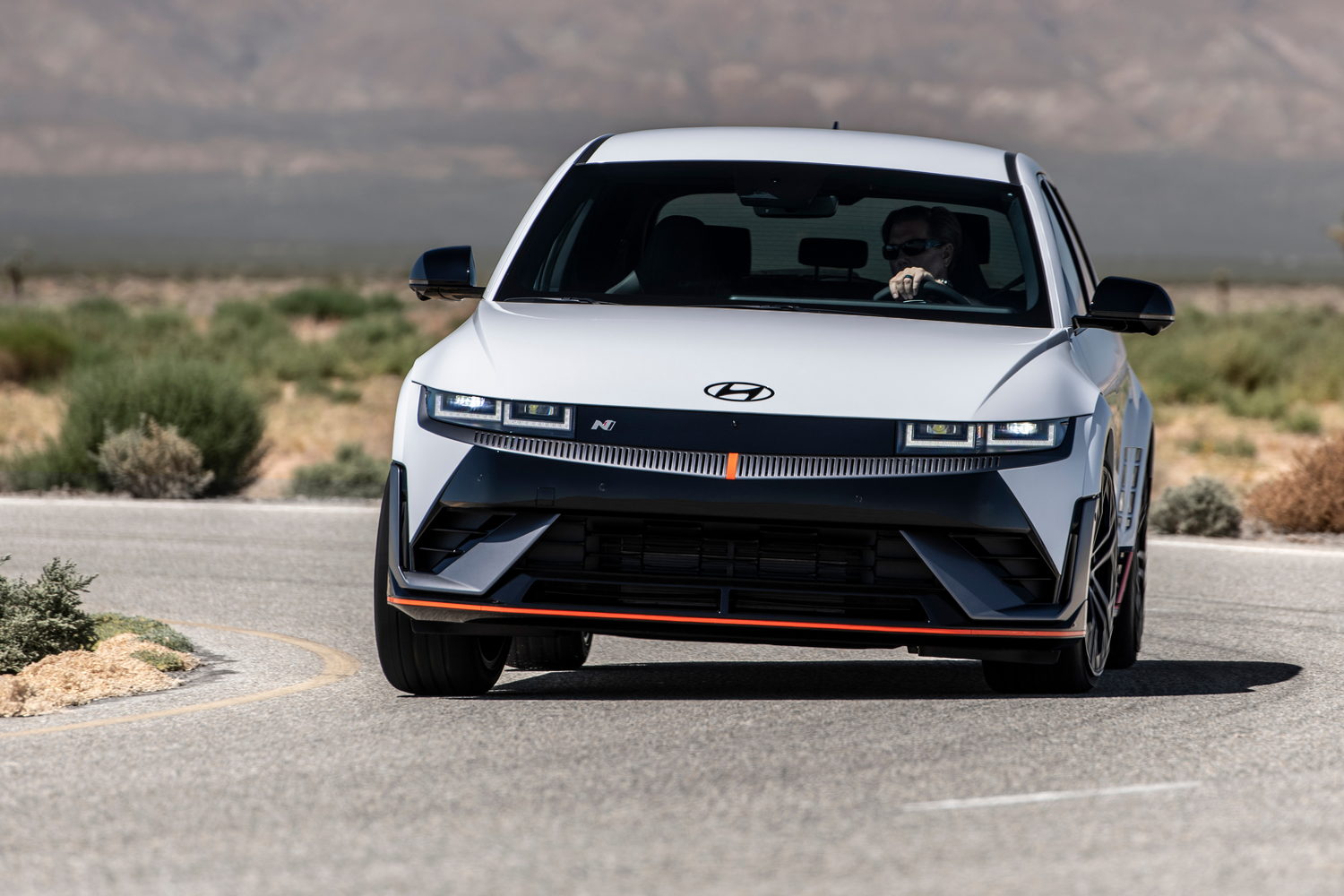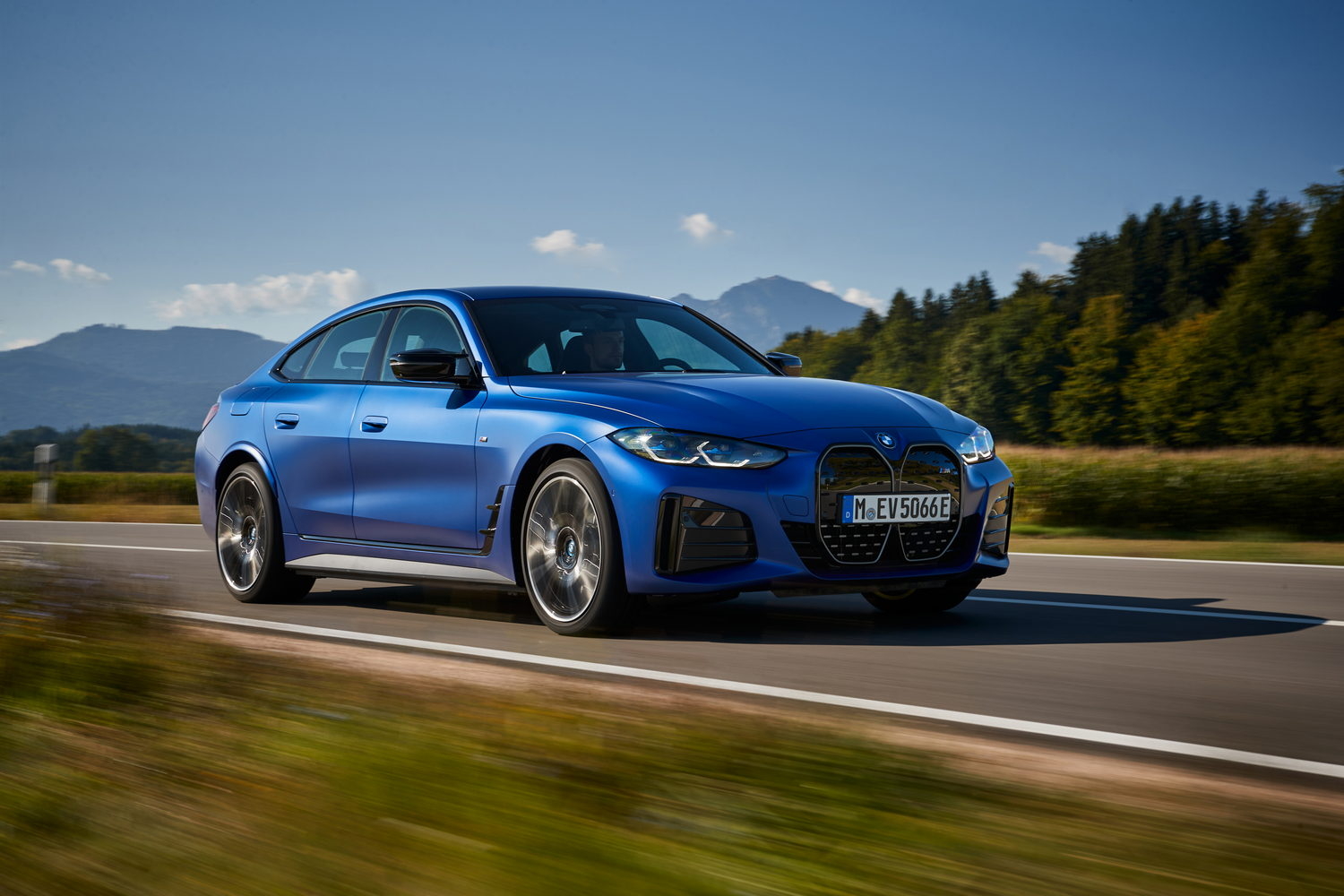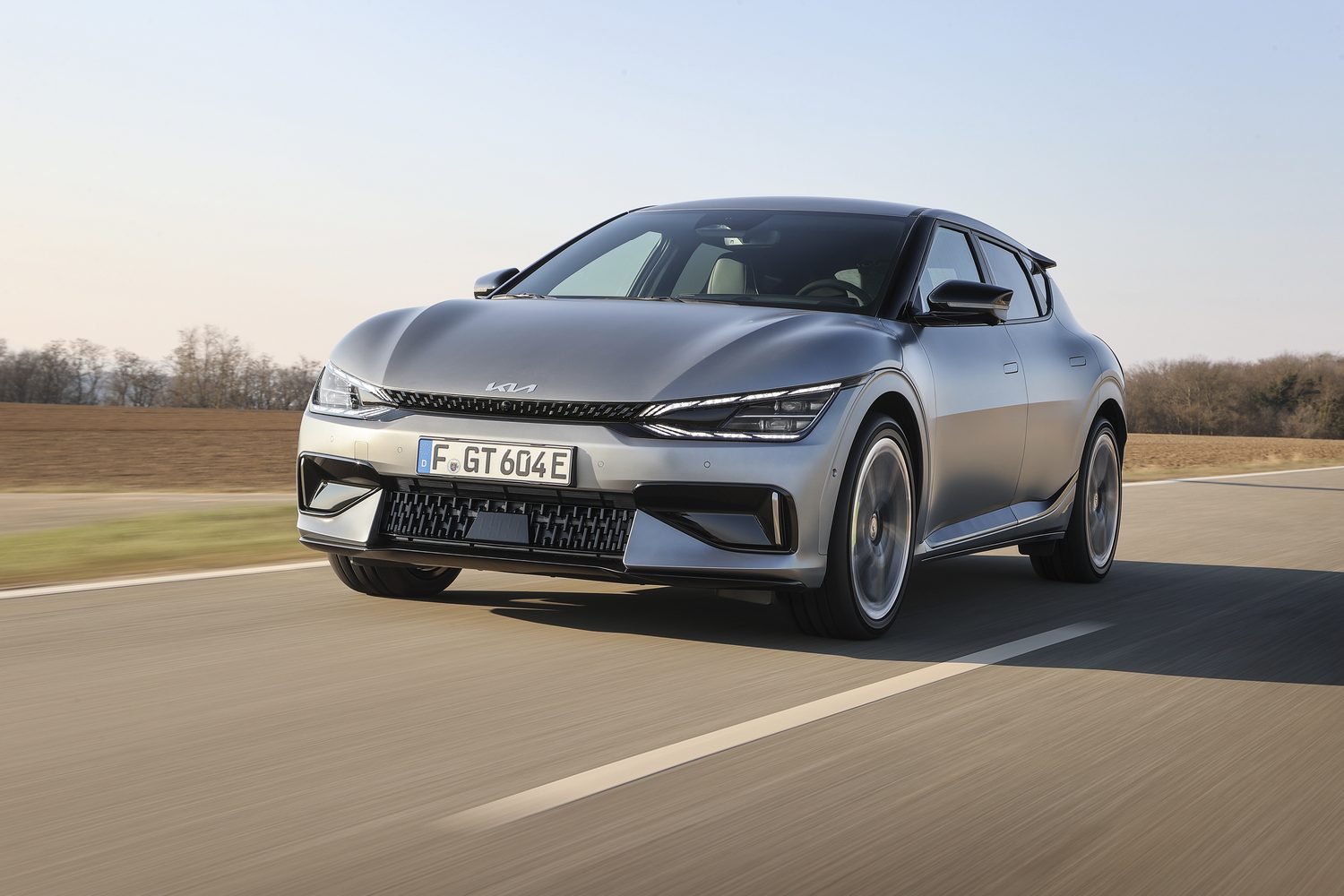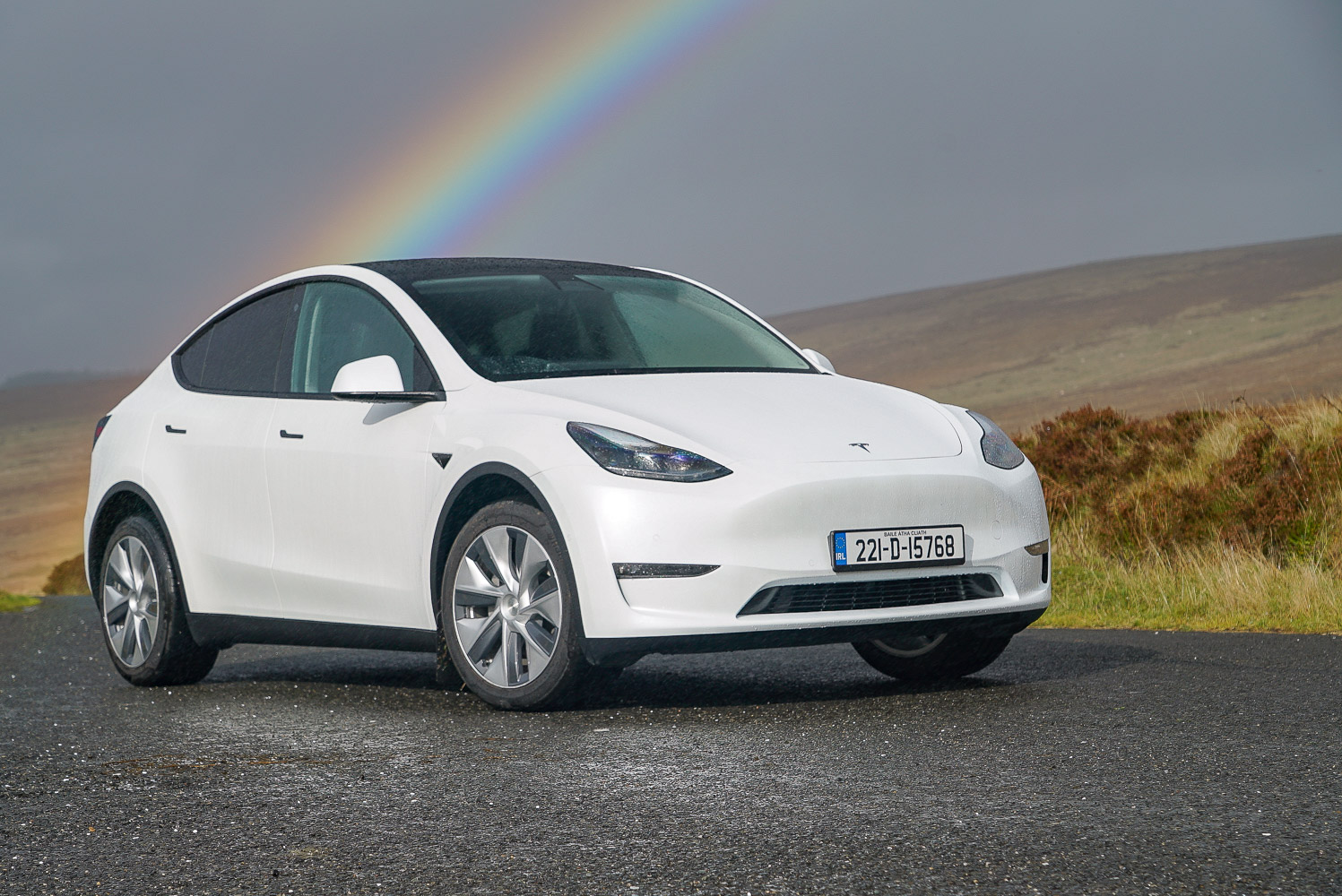The Hyundai N brand has made a big splash with car enthusiasts in its relatively short life, and now it's set to create waves with its first all-electric car, the Ioniq 5 N. Based on the distinctive and likeable Ioniq 5, the N model ramps up the performance and driver involvement using a mix of serious hardware and fun-focused software to create something quite unique in the market. It looks the part, but is it good enough to convince petrolheads that electric power can deliver their kind of car?
In the metal
In a dark colour, you might miss the N version of the Ioniq 5 driving past, as the makeover is muscular and largely functional rather than over the top. A brighter paint colour as shown here reveals the contrasting black detailing front, rear and on the side sills, but most of the changes are not just for effect, as the N model has additional cooling vents and it gets an aerodynamic overhaul extending to a lower front apron, new roof spoiler and rear diffuser. That's all highlighted by an orange stripe, while the wider tracks are accommodated by beefier bodywork, too.
Large 21-inch alloy wheels sit on wide Pirelli P Zero tyres and the ride height is lower than the standard car's so the N variant has a squat stance all its own. The 'parametric pixel' lights are complemented by 'chequered flag' reflectors in the rear bumper, too.
That motif can be found in the door sills as well on entry to a heavily N-branded interior that's darker in theme than the standard Ioniq 5's. The same five-seat layout is used, though the front chairs are new low-slung bucket seats with tactile upholstery and illumination of the N logo.
Ahead of the driver is a thick-rimmed steering wheel with a relatively small central boss and paddles behind. The standard twist-forward-to-go drive selector is present and correct though there are additional buttons on the wheel unique to the N model. The pale blue "Drive Mode" option's purpose is obvious enough, though it opens up a vast menu of customisation options for the driving systems on the touchscreen, which we'll go into below in more detail. Thankfully, the driver's favourite selection of settings can be programmed into two distinct modes, quickly selectable from the N buttons below the spokes of the wheel. The bright red button, meanwhile, is marked "NGB" for N Grin Boost and it allows access to the electric motors' full performance for up to 10 seconds at a time.
Driving it
And 'full performance' in the Ioniq 5 N is quite something. There are powerful electric motors front and rear for all-wheel drive and by default they combine to put out 609hp. Press the NGB button, however, and that's upped to 650hp for 10 seconds. And it's backed up by a huge 770Nm of torque. That helps explain how this 2,235kg hatchback hits 100km/h from rest in just 3.4 seconds... If you feel the need, there's launch control, too, with three different selectable levels of traction assistance. That hints at the amount of personalisation of the driving experience available to the driver.
It doesn't convey how engaging the Ioniq 5 N is, however. After all, we've tested plenty of high-powered electric cars with otherworldly acceleration - that doesn't always go hand in hand with driver involvement, something Hyundai was adamant this car would have in spades.
Some of the features are a little gimmicky, but we appreciate the effort to make this car fun. There's a software system, for example, that is designed to simulate the operation of an eight-speed, dual-clutch gearbox. Hyundai calls it N e-shift and while allowing the driver to 'change gear' using the paddles usually reserved for altering the brake energy regeneration, it also introduces slight lurches in the delivery from the electric motors. It's entirely unnecessary and actually a little pointless unless you've also got the N Active Sound+ feature switched on.
Using two external speakers and another eight inside the cabin, this gives the Ioniq 5 N a voice in line with how it is being driven. It can be switched off completely, or there are three different themes to choose from. The first is called Supersonic, mimicking the noise a twin-engined fighter jet makes. It's surprisingly entertaining, though it seems at odds with the simulated gearchanges (those can be turned off of course). Next up is 'Evolution', which we're told was inspired by the Hyundai RN22e concept car. I wasn't massively impressed by that.
My favourite was the 'Ignition' setting, designed to sound just like Hyundai N's early internal-combustion-engined cars such as the i30 N and Kona N. It's convincing, too, especially when you're going up and down the 'gears' using the paddles. Regardless of which setting you choose, there are three different levels of intensity to select from as well.
Indeed, as has become Hyundai N's way, the driver can set the car up in minute detail to their liking. For the custom driving modes, there are three levels for each of the electric motor, steering, damping, electronically-controlled limited-slip rear differential and stability control - along with the sound. Swipe to the next screen on the infotainment and there's even more to adjust.
N Torque Adjustment allows the driver to vary the front-to-rear torque distribution over 11 steps (though obviously within the outputs of the electric motors). N Pedal uses brake energy regeneration to shift the weight balance of the car as it enters a corner, resulting in sharper-feeling turn-in. And if you like to shred tyres (on track only please), there's the N Drift Optimizer to make you feel like a drifting king or queen. Built into that is the Torque Kick Drift feature that operates a little like popping the clutch in a manual car, the idea being that it can quickly unsettle the rear axle to smartly initiate a drift.
And Hyundai is backing up all its marketing talk about track capability by endowing the Ioniq 5 N with a suitably upgraded electric powertrain including a significant upgrade to the cooling of the motors and temperature control of the battery pack. Using the N Battery Pre-conditioning feature, the driver can choose from Drag or Track modes, optimising the battery for a short burst of full power or more laps, respectively. The N Race system builds on that with Endurance or Sprint settings balancing energy use and outright performance.
We realise that this is beginning to sound more like a computer game than a serious performance car, but thankfully all this window-dressing is backed up by solid foundations and proper hardware. There's a lowered chassis, stiffer body shell and three-stage adaptive damping, for example, along with the sophisticated differential mentioned above.
While we expect owners to take their time to learn their way around the car and develop their own preferences, it is possible to just jump in and drive it in its default settings, too. Indeed, we didn't have hours at the wheel, nor a racetrack at our disposal, but we still managed to get a feel for the car's personality over a variety of roads, varying from poorly-surfaced city streets to a fast-flowing motorway and then, arguably its natural habitat, a sinuous mountain road.
Despite all the upgrades - and the ultra-low-profile tyres - the suspension is perfectly malleable at everyday speeds when the damping is in its Comfort setting. Sure, it's firmer than the standard Ioniq 5 over bumps, but the kind of buyer that actually goes for this car won't be put off. Same story on the motorway where it flows along smoothly and - if you've the sound synthesiser system switched off - quietly.
And then you come to a tight corner and response to the steering is immediate, the car moves all apiece through the turn and body control is spot on. It feels like a sorted chassis, and it doesn't take long to realise that grip levels are off the scale in the dry, too. Grip doesn't always mean fun, of course, but this is certainly fun and it's far more agile and 'chuckable' than any vehicle its weight has any right to be.
The huge brakes had no issue with our enthusiasm and apparently brake energy regeneration is used to a larger extent in this car than usual in a bid to manage the weight while driving on track. And while a figure as high as 650hp sounds ludicrous, response to inputs from the accelerator are measured so it's not at all intimidating to drive quickly.
What you get for your money
At first, the €79,995 asking price for the Ioniq 5 N in Ireland looks as crazy as its power output figure, but if you can find another new car with up to 650hp for much less than double that, please do get in touch. And as outlined above, there's a lot more to this car than its straight-line performance. Sure, the entry-level Ioniq 5 costs just €44,495, and the top-of-the-range version offered to Irish buyers is still considerably more affordable than the N model at €55,815, but even that doesn't have two motors and all-wheel drive, as well-equipped as it is. At the end of the day, this isn't ever expected to be a big seller, but we don't think it's excessively expensive for what you get, either.
Summary
Even knowing the specification and Hyundai's own mission statement for the N brand, I really didn't expect the Ioniq 5 N to perform like a car you'd actually want to bring to a race circuit. But it is. And yet that's not the only environment in which it will excel and excite its driver. This is a very new type of performance car, enabled by its electric powertrain rather than being compromised by it. I look forward to spending more time with it to properly get under its multi-layered skin.














































